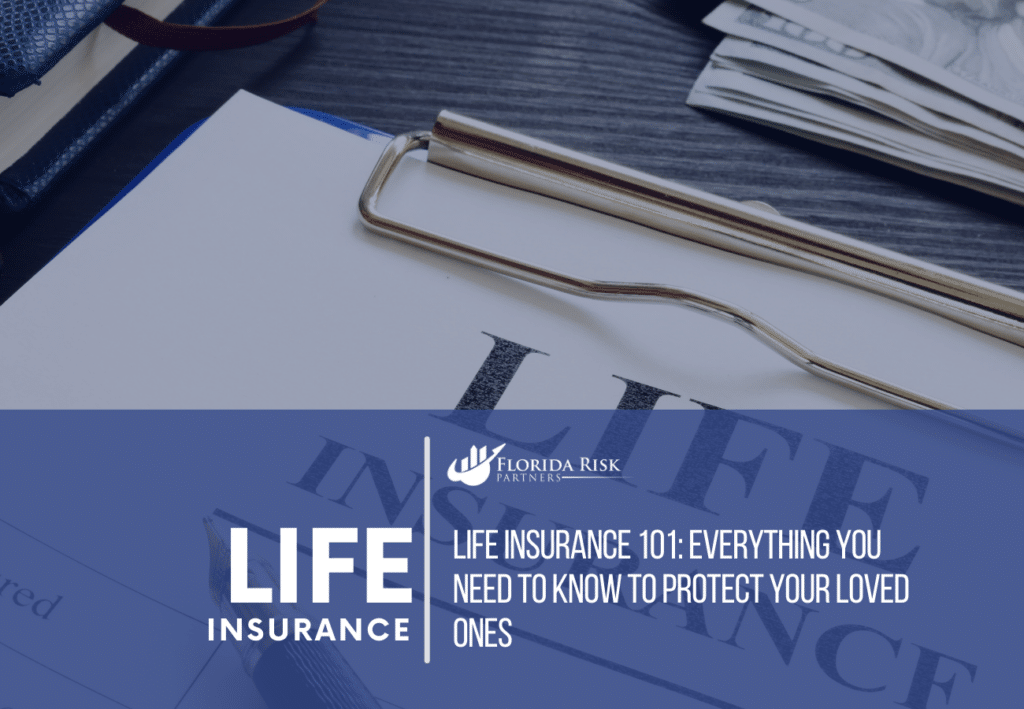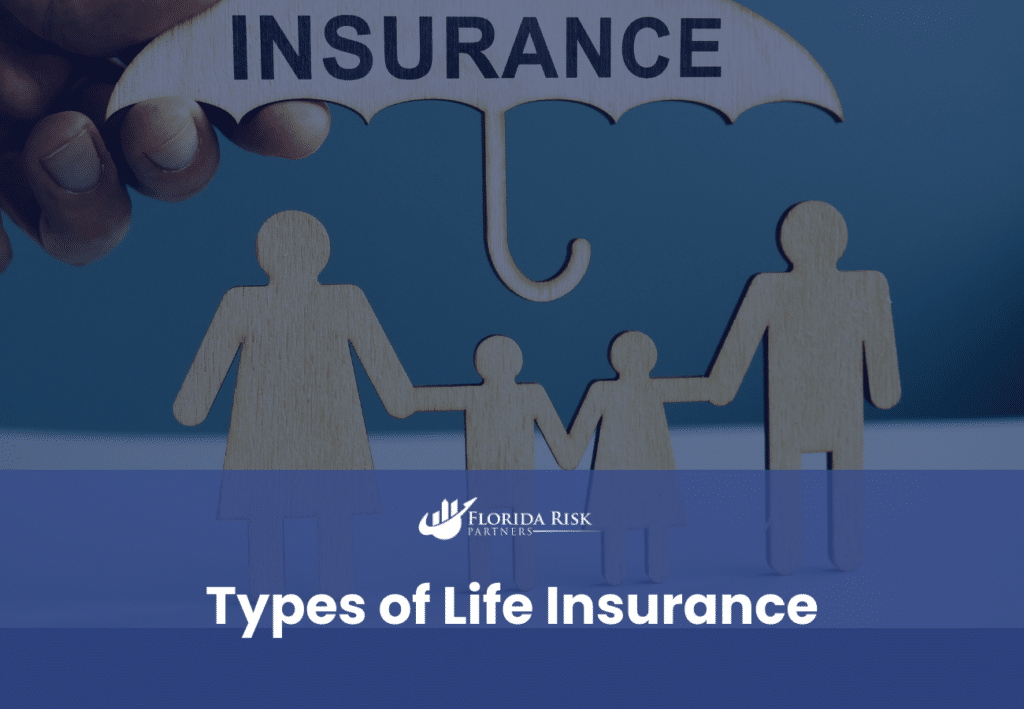-
Main Office: 1434 E. Bloomingdale Ave Valrico, FL 33596-6110
-
Phone: (888) 601-6660
-
Email: info@floridariskpartners.com

Life insurance is one of the most important financial tools available, yet it’s often misunderstood or overlooked. If you’ve landed here, chances are you’re considering life insurance but have questions about how it works, what types of policies are available, and whether it’s the right choice for you. This guide will walk you through the fundamentals of life insurance, helping you make informed decisions to protect your loved ones and secure their financial future.
By the end of this article, you’ll understand the key aspects of life insurance, how it can benefit your family, and why acting sooner rather than later is crucial. Plus, we’ll introduce you to a comprehensive eBook that dives even deeper into the subject. Let’s get started.
Download our Complimentary Buyer’s Guide
What Is Life Insurance?
At its core, life insurance is a contract between you and an insurance company. You agree to pay premiums—monthly, quarterly, or annually—and in return, the insurer promises to pay a lump sum (the death benefit) to your designated beneficiaries if you pass away while the policy is active.
The primary purpose of life insurance is to provide financial security for your loved ones. It ensures that even in your absence, they can cover daily expenses, pay off debts, and maintain their quality of life.
Why It Matters:
Life insurance isn’t just for covering funeral costs. It’s about protecting the people who depend on you financially, whether that’s your spouse, children, aging parents, or even business partners.
Types of Life Insurance
Choosing the right type of life insurance can feel overwhelming, but understanding the basics makes it much simpler. Here are the primary types of life insurance policies:
1. Term Life Insurance
Term life insurance provides coverage for a specific period, such as 10, 20, or 30 years. It’s straightforward and typically the most affordable option. If the insured passes away during the term, the death benefit is paid to the beneficiaries. If the term ends before death, the policy expires with no payout unless it’s renewed or converted.
- Best For: Young families, individuals with limited budgets, or those who need temporary coverage for specific financial obligations (e.g., a mortgage).
- Key Benefits: Affordable premiums and high coverage amounts.
- Drawbacks: No cash value or benefits after the term ends.

2. Whole Life Insurance
Whole life insurance is a type of permanent life insurance that provides coverage for your entire life, as long as premiums are paid. It also includes a cash value component that grows over time at a guaranteed rate.
- Best For: Those who want lifelong coverage and a savings component to build wealth.
- Key Benefits: Guaranteed death benefit, fixed premiums, and cash value accumulation.
- Drawbacks: Higher premiums compared to term policies.
3. Universal Life Insurance
Universal life insurance is another form of permanent insurance but offers more flexibility. You can adjust your premiums and death benefit to adapt to changing financial needs, and the cash value grows based on market interest rates.
- Best For: People with fluctuating incomes or those looking for a customizable policy.
- Key Benefits: Flexible premiums and death benefit, potential for higher cash value growth.
- Drawbacks: Requires active management and has more complex terms.
4. Final Expense Insurance
Final expense insurance is designed to cover end-of-life costs, such as funeral expenses and medical bills. These policies typically have lower death benefits and are aimed at seniors.
- Best For: Older individuals who want to ease the financial burden on their families.
- Key Benefits: Affordable premiums and straightforward application process.
- Drawbacks: Limited coverage amounts.
How Does Life Insurance Work?
When you purchase a life insurance policy, you’ll make several key decisions, including:
- The Coverage Amount: This is the total death benefit your beneficiaries will receive.
- The Policy Term: If choosing term life insurance, you’ll select the length of coverage.
- Beneficiaries: The people or entities who will receive the death benefit.
- Premium Payments: Regular payments to keep the policy active.
If you pass away while the policy is active, your beneficiaries file a claim with the insurance company. Once approved, the insurer pays out the death benefit, typically as a tax-free lump sum.
Who Needs Life Insurance?
Life insurance is not a one-size-fits-all solution, but almost everyone can benefit from having some level of coverage. Here’s a breakdown of common scenarios where life insurance is essential:
- Young Families: Protect your spouse and children by replacing your income and covering childcare or education costs.
- Homeowners: Ensure your family can pay off the mortgage and keep the home.
- Business Owners: Fund buy-sell agreements or cover business debts to protect your partners and employees.
- Single Adults: Lock in affordable premiums while young and healthy, or cover debts that could burden your loved ones.
- Retirees: Provide for a surviving spouse, leave a legacy, or cover estate taxes.
The Benefits of Life Insurance
Life insurance offers a wide range of benefits, many of which go beyond the death benefit:
- Income Replacement: Ensures your loved ones can maintain their lifestyle after losing your financial contributions.
- Debt Protection: Covers outstanding debts like mortgages, car loans, or credit cards.
- Legacy Building: Allows you to leave an inheritance or support a charitable cause.
- Education Funding: Provides for your children’s college tuition and related expenses.
- Business Continuity: Protects businesses by funding buyouts or covering operational costs.
- Tax Advantages: Most death benefits are paid tax-free, and permanent policies offer tax-deferred cash value growth.

How to Choose the Right Policy
Selecting the right life insurance policy depends on your financial goals, budget, and personal circumstances. Follow these steps to make an informed choice:
- Assess Your Needs: Use tools like the DIME formula (Debt, Income, Mortgage, Education) to calculate how much coverage you need.
- Determine Your Budget: Choose a policy that provides adequate coverage without straining your finances.
- Consider Your Goals: If you need temporary coverage, term insurance may be best. If you want lifelong protection or cash value, look into permanent options.
- Compare Providers: Research insurers for financial strength, customer reviews, and policy options.
- Work with an Agent: A knowledgeable agent can guide you through the process and help you find the best policy for your needs.
Overcoming Common Misconceptions
Many people delay buying life insurance due to misconceptions or fears. Let’s address some common myths:
- “I’m too young for life insurance.” Life insurance is most affordable when you’re young and healthy. Waiting only increases costs.
- “I can’t afford it.” Term life insurance is surprisingly affordable, with many policies costing less than a cup of coffee per day.
- “I have savings, so I don’t need it.” Savings can be depleted quickly in emergencies, while life insurance guarantees a set payout.
Why You Should Act Now
Procrastinating on life insurance can have serious consequences. Premiums increase with age, and unforeseen health changes can make it harder—or even impossible—to qualify for coverage. By acting now, you can lock in lower premiums and ensure your family is protected.
Next Steps: Download Our Free eBook
Life insurance is a complex subject, and this guide has only scratched the surface. For a deeper dive into the types of policies, their benefits, and how to choose the right one for your needs, download our free eBook: “Life Insurance Demystified: Protecting What Matters Most.”
In this comprehensive guide, you’ll learn:
- The difference between term and permanent life insurance.
- How to calculate your coverage needs.
- Real-life stories illustrating the importance of life insurance.
- Common mistakes to avoid when buying a policy.
Download the Free eBook Now to take the next step in securing your family’s financial future.
Conclusion
Life insurance is an essential tool for protecting your loved ones and ensuring their financial stability, no matter what life brings. Whether you’re looking to cover immediate needs, leave a lasting legacy, or safeguard your business, there’s a policy designed to meet your goals.
Don’t wait until it’s too late. Start exploring your options today and take the first step toward peace of mind. For more detailed information, download our eBook and equip yourself with the knowledge to make confident, informed decisions about life insurance.
Your family’s future depends on it.
Call Us Or
Schedule an Appointment
Select an agent below to view our online calendars and select a day and time that works best for you or call us directly at 888-601-6660. When you use our online calendars, you will receive an email with more information.



